Battle of the birds: interview with Tim Birkhead Understand article
Tim Birkhead tells Karin Ranero Celius about promiscuous birds and teaching science students.
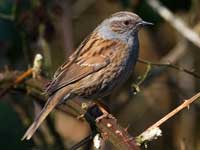
Image courtesy of
Wenkbrauwalbatros; image
source: Wikimedia Commons
“Be thou like the dunnock – the male and female impeccably faithful to each other,” said Reverend Frederick Morris in 1853. In an attempt to preach fidelity, he encouraged his parishioners to behave like dunnocks (Prunella modularis) – small, brown, rather plain-looking birds. Far from being monogamous, however, the dunnocks – from a Victorian point of view – have shockingly lax morals, with the female often mating with several males. What would Reverend Morris have made of the scandalous truth?
Tim Birkhead, professor of behavioural ecology and the history of science at Sheffield University, UK, has devoted nearly 40 years to the study of promiscuity in birds. From Darwin’s time up to the late 1960s it was thought that male animals competed for female partners, with the strongest and most attractive males impregnating the most females, and that females sought only the security of monogamy, copulating with multiple partners only when forced. The unladylike truth that gradually emerged, however, is that females of most species actively seek multiple partners to mate with, an evolutionary strategy to get the very best sperm to fertilise their eggs.
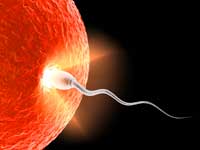
moment of fertilisation: a
sperm gains entry to an
ovum
Image courtesy of Raycat /
iStockphoto
Indeed, rivalry between males and discrimination by females extends beyond the sexual act itself. Inside the female, the sperm of different males fight for supremacy – this is sperm competition. At the same time, the female may be able to select the sperm that are best for her – this is sperm choice. This is the true battle of the sexes. The males and females of each species are permanently locked in a struggle to out-evolve each other, as their reproductive anatomy and behaviour change to achieve their conflicting aims: maximum fertilisation versus best fertilisation.
These radical ideas were just beginning to emerge when Tim Birkhead graduated from university in 1972. “I just feel incredibly fortunate to have been the right age, at the right place and the right time,” he says.
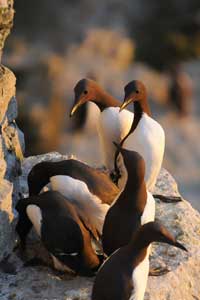
Image courtesy of davthy /
iStockphoto
Tim’s initial interest was in sea birds. In 1972, he started a project to monitor guillemots on Skomer Island, a nature reserve in Wales: he looked at the adult and immature survival rates and the age of the first breeding and reproductive success, as well as assessing the effects of oil pollution and climate change on the population. Although the project continues and he returns to Skomer Island regularly, the focus of his research gradually moved towards sex. In particular, post-copulatory sexual selection.
Tim Birkhead’s research has helped to re-shape our understanding of bird mating systems. Why should a bird or an individual copulate with more than one partner? What determines which male fertilises the female’s eggs when she has mated with several partners? And how are sexual conflicts resolved? His research involves finding out what happens to the sperm of the male inside the female’s reproductive tract and investigating the importance of sperm competition and sperm choice in determining which male fertilises the eggs.
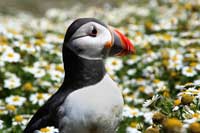
resident: the puffin
Image courtesy of Julie
Langford; image source:
Wikimedia Commons
In his ongoing quest to explore the nature of sexuality, Tim Birkhead could be considered a paparazzo of nature – travelling to remote islands and bearing extreme discomfort in the hope of catching birds mating, and when they do, splashing their most intimate details and pictures over the pages of science journals.
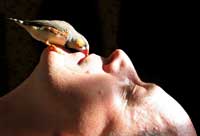
finch, Taeniopygia guttata
Image courtesy of Francesca
Birkhead
Tim’s passion for birds goes way back – to when he was 11. “On one memorable holiday in Wales, my father took me to a little island called Bardsey Island – one of the most beautiful places in the world, with lots of wonderful birds. As we walked back at the end of the day, a young man sat looking through a telescope with a notebook and my dad just looked at me and said: ‘You could do something like that when you get older’.” And he did.
But Tim is not always the observer; often, he is the one in the spotlight. A good scientist must be able to communicate his research and engage audiences by making it relevant and Tim does just that: he illustrates science with many stories, and he’s clever, funny, persuasive and very clear. In fact, he is one of those teachers whose lectures should be scheduled early in the morning to make it worth the students’ while to get out of bed. What makes his lessons so special? His enthusiasm is surely part of the answer.
Field courses and tutorials are Tim’s preferred teaching methods. “I think intellectual development hinges very strongly on personal exchange. Tutorials are important for students to hear us talking to them, and for them to answer so that we can help shape their arguments. In field courses, similarly. I love teaching field courses because you can see the kids grow in that week. I teach a field course that takes place in June. The first day is appalling, but by the end of the week they are fantastic. However, they have trouble retaining that knowledge and enthusiasm, so when they come back in September it’s as if nothing has happened. I feel we ought to be doing four or five field courses, and by the end of that time a lot of the information and enthusiasm and way of doing science would have stuck.”
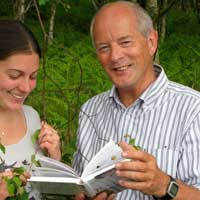
Image courtesy of John Smith
Doing science is important, but so is understanding science itself. “The history of science course that I teach is about doing science and what it means to be a scientist. I try to teach it in an unconventional way: I don’t let my students take notes because I want them to listen, to be inspired by what I tell them and then go off and do the necessary reading. For one of the major assessments, I take them to a place where, based on their reading and a quote I give them, they have to organise a conference for the day. It’s up to them entirely how they interpret it, and how they give the presentation, and everybody does it very differently. They learn about the history of science by listening to their peers.”
Tim also enjoys sharing his enthusiasm for science with school students. “Two or three weeks ago I gave a talk at a school where the students were incredibly mature. As I said, most of my research is on sexual selection and reproduction, and I was a bit apprehensive about telling 16- and 17-year-olds about reproduction, but they were fantastic. They asked really innovative questions, and there wasn’t any silly giggling. I think with a group like that, you could really get across what science is, although with other types of kids it might be a bit difficult.”
What would Reverend Morris have made of that talk, I wonder? Perhaps he too would have concluded that he would have been better preaching to the dunnock about the virtuous ways of the human.
This article is based on an interview with Tim Birkhead, as well as his lecture ‘Darwin and post-copulatory sexual selection’ at the 11th EMBL / EMBO Science and Society Conference: The Difference between the Sexes – From Biology to Behaviour, on 5-6 November 2010.
Resources
- To learn more about Tim Birkhead, see: https://www.shef.ac.uk/aps/staff-and-students/acadstaff/birkhead
- To see one of Tim Birkhead’s talks, see: www.thedolectures.co.uk/speakers/speakers-2009/tim-birkhead
- Another talk by Tim Birkhead (‘The early birdwatchers’) can be watched on TED, an online collection of lectures: www.ted.com/talks/tim_birkhead_the_wisdom_of_birds.html
- To learn more about research into dunnock promiscuity, see:
- Davies, NB (1983) Polyandry, cloaca-pecking and sperm competition in dunnocks. Nature 302: 334-336. doi: 10.1038/302334a0
- Download the article free of charge here, or subscribe to Nature today: www.nature.com/subscribe
- Haubold B (2007) Review of The Selfish Gene and Richard Dawkins: How a Scientist Changed the Way We Think. Science in School 5: 84-85. www.scienceinschool.org/2007/issue5/selfish
- Dawkins R (2006) The Selfish Gene, 3rd edition. Oxford, UK: Oxford University Press. ISBN: 9780199291151
Review
If “nothing in biology makes sense except in the light of evolution” (Theodosius Dobzhanky, 1900-1975) this article will be appealing and enjoyable for all biology teachers. It focuses on Professor Tim Birkhead, his life and his research, but also introduces another interesting topic – animal promiscuity and sexual selection – which is probably new for many readers and uncommon in teaching evolution at school.
The article is based on an interview, so the style is pleasant and witty; moreover some difficult points (sperm competition and sperm choice) are explained in a clear and vivid way (for instance, in the synthesis of the battle of sexes, as “maximum fertilisation versus best fertilisation”).
The story of Birkhead’s life and career is interesting and inspiring for young students attracted by the study of animal behaviour and evolution; his personal methodology in teaching the history of science will also provide science teachers with new and stimulating ideas.
Finally, this article shows that the study of evolution is an ever charming and surprising adventure.
Giulia Realdon, Italy





